Weekends for us are all about fast cars and slow food. Last week DP and I celebrated the first Formula One Grand Prix at Mugello by having a little Tuscan themed race day. We opened the windows of our little New York apartment and imagined being outside at the track, crammed next to fellow tifosi, hearing the roar of the engines and seeing the cars whizz by in front of us. Watching at home, we would occasionally catch a whiff of our Ragu Bianco simmering in the kitchen. DP would argue, but I’ll take that over the smell of motor oil any day.
We had some Berkshire pork shoulder from our friends at Fossil Farms, and I knew Ragu Bianco would be the perfect way to bring out its subtle earthiness and beautiful marbling. Unlike its more assertive cousin, Ragu Bolognese, Ragu Bianco contains no tomato product. Instead the meat is simmered slowly in gelatin-rich broth with just a few ingredients: onions, fennel, garlic, herbs, white wine and a touch of cream to add body to the sauce. I don’t use rosemary because it always seems to be too assertive, but I do add pinch of clove and nutmeg for warmth, and a couple teaspoons of porcini powder for a bit of umami. If you don’t have porcini powder, a little soy sauce will do the trick.
The result is a rich ragu that’s restrained yet aromatic. Tender bits of pork suspended in velvety sauce cling to the fresh pappardelle. Just before serving I brighten things up with some freshly grated lemon zest and chopped parsley. And for the table, provide parmigiano reggiano, freshly ground black pepper, and crunchy sea salt. Serve with plenty of Barbera d’Alba or Barolo wine.
Pork Ragu Bianco
Ingredients, for 6 to 8 servings
| 2 lb (900 g) | boneless pork shoulder, trimmed |
| 2 Tbsp (30 ml) | extra virgin olive oil or pork fat |
| 2 cups (270 g) | diced onions |
| 2 cups (270 g) | diced fennel bulb |
| 4 to 8 ea (20 to 40 g) | garlic cloves, smashed |
| 1/2 cup (120 ml) | white wine |
| 2 cups (480 ml) | rich pork or chicken stock (bone broth) |
| 1/2 cup (120 ml) | heavy cream |
| 1 pinch | ground cloves, to taste |
| 1 pinch | ground nutmeg, to taste |
| 8 ea | fresh thyme sprigs |
| 2 ea | fresh sage sprigs |
| 3 ea | bay leaves |
| 1 1/2 tsp | porcini mushroom powder |
| salt & pepper, to taste | |
| 2 lb (900 g) | fresh pappardelle pasta |
| 1 ea | lemon, zest only, grated |
| 1/4 cup | fresh chopped parsley |
Instructions:
Step 1, Brown the pork: Trim away any very large chunks of fat, cut the pork into 1-inch cubes and pat them dry. Heat olive oil in a large heavy bottomed pot or Dutch oven. Working in batches, lightly brown the pork on all sides. Transfer browned pork to a bowl or plate, toss with a little salt and pepper, and set aside.
Step 2, Sweat the vegetables: Lower the heat, and add the onions, fennel, and garlic to the pot, using additional olive oil if necessary, to lightly coat the vegetables. Add a small pinch of salt and gently cook on medium-low heat until the onions are soft and translucent. Cook them slowly to release their sugars before everything else goes in the pot.



Step 3, Deglaze with wine: Add white wine and simmer for about 5 to 10 minutes, scraping up any browned bits from the bottom of the pan.
Step 4, Simmer and wait: Return the pork to the pan. Add the heavy cream, and enough chicken stock to cover the ingredients. Mix in ground cloves, nutmeg, and mushroom powder. Tie the herbs tightly together and add the bundle to the pot. Cover and simmer gently on low heat for 2 hours, until the meat is tender and breaks apart with a fork.




Step 5, Reduce the ragu: Once the meat is tender, uncover the ragu. Simmer for about 30 minutes more, reducing the liquid, and periodically stirring to make sure it’s not sticking to the pot. Continue reducing and breaking up the pieces of pork until the sauce is rich and thick, with short meat fibers that will cling to the pasta. Add salt and pepper to taste.
Step 6, Cook the pasta: When the ragu is ready, bring a large pot of water to a boil, add a large pinch of salt and cook your pasta until it’s al dente. Fresh pasta should take no longer than 2 to 3 minutes. Drain the pasta, setting aside some of the cooking liquid.
To assemble: Add the drained pasta directly to the ragu, and stir briefly over low heat until the pasta is well coated, but not overcooked. If the ragu is too dry you can add in a little pasta water or additional heavy cream to coat the pasta. Mix in the fresh parsley and grated lemon zest. Serve immediately.




